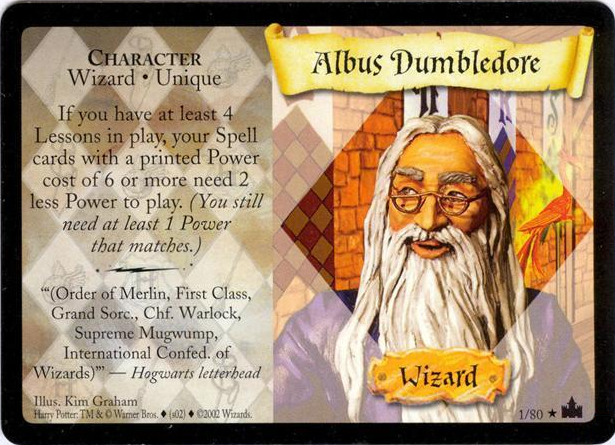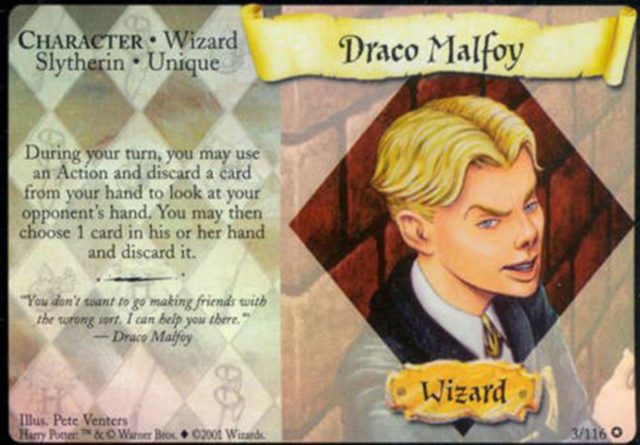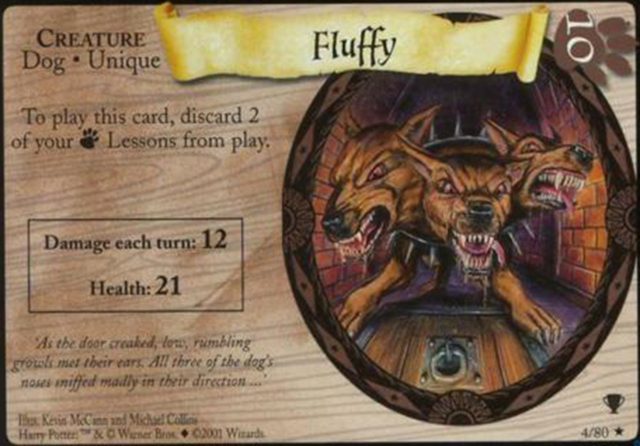Harry Potter was running late for his Transmogrifaction lesson, racing across the grounds of Hogwarts, when out of nowhere, a Blast-End Skewert jumped out. Ready, Harry tossed a potion out from under his robes, paralyzing the Skewert in its path.
This, as far as I can remember, never actually happened in the books (I’ve read them once, a long time ago), but it is a scene that can play out in the Harry Potter Trading Card Game, released in 2001 by Wizards of the Coast. For those that are familiar with my Crusty Cardboard series, you know I always start with an imagined scene from the game. One of the reasons I like the T/L/CCGs I play is that they can play out wonderful and rich scenes from universes I like visiting. If you’re saying to yourself, “but that doesn’t sound like a rich scene at all, Tim,” you’re right. Not to race ahead, but one of my major issues with Harry Potter TCG is that it doesn’t really capture the feel of Harry Potter. Sigh.
 In Harry Potter TCG, each player picks one of five “lessons” – Care of Magical Creatures, Charms, Potions, Quiddich, or Transfigurations, and builds a sixty card – exactly sixty card – deck. It is possible to mix and match the “lesson” types to have a multi-faction deck, but at least in the time when I played, those decks were not as strong as a single-lesson deck. Most cards in your deck will do damage; for every point of damage you suffer, you must discard the top card of your deck. When your deck runs out, you lose. On your turn you take two actions. These actions can be to draw a card, or to play a card from your hand – either to put a creature into play, or to play a spell or potion. Creatures damage your opponents at the start of every turn until they are removed, and spells and potions do things like damage your opponent, or a creature, heal you, or some other trickery. The game is fundamentally quite simple to play.
In Harry Potter TCG, each player picks one of five “lessons” – Care of Magical Creatures, Charms, Potions, Quiddich, or Transfigurations, and builds a sixty card – exactly sixty card – deck. It is possible to mix and match the “lesson” types to have a multi-faction deck, but at least in the time when I played, those decks were not as strong as a single-lesson deck. Most cards in your deck will do damage; for every point of damage you suffer, you must discard the top card of your deck. When your deck runs out, you lose. On your turn you take two actions. These actions can be to draw a card, or to play a card from your hand – either to put a creature into play, or to play a spell or potion. Creatures damage your opponents at the start of every turn until they are removed, and spells and potions do things like damage your opponent, or a creature, heal you, or some other trickery. The game is fundamentally quite simple to play.
Each of the factions has a specific focus. Creatures stay in play, and damage opponents. Charms tend to do damage, and have some other effect. Potions are quite powerful – they can do a lot of damage, or return cards from your discard pile to your deck, but usually require you to sacrifice a card from play. Quiddich cards usually have two separate effects, while Transfigurations tend not to do a lot of direct damage, but can remove cards from play, or change the nature of the cards. This brings me to one of the serious limitations of Harry Potter TCG – in most of the games I played, Potions won almost all the time. This is a hallmark of a balance issue in a CCG – if one faction wins more than what should be statistically average, you probably haven’t designed or playtested the game well.
 The game is, well, quite basic, and not really a great game. You take two actions, I take two actions, and we go back and forth. The game moves quite quickly because of this – which can be a good thing – but there’s not a lot of room to develop cool combos or multiple turn strategies, something I quite like in CCGs. Besides my issue with Potions potentially being quite overpowered, the other serious issue I have with the game is that it doesn’t really feel like Harry Potter.
The game is, well, quite basic, and not really a great game. You take two actions, I take two actions, and we go back and forth. The game moves quite quickly because of this – which can be a good thing – but there’s not a lot of room to develop cool combos or multiple turn strategies, something I quite like in CCGs. Besides my issue with Potions potentially being quite overpowered, the other serious issue I have with the game is that it doesn’t really feel like Harry Potter.
I’ve thought about some of these issues, and I do wonder if it is possible to “hack” the game to make it slightly more playable. First, while the rules don’t set up multiplayer play, I do believe it would be possible to play multiplayer. This may fix some issues – if you could choose between players to attack, it might set up some more strategy in the game, and make for some more interesting decisions. I also have toyed around with modding the game so that damage can be taken from anywhere – you can discard a card from your hand, or discard a card from play, to absorb damage. Again, this makes the game last a little longer, and leads to slightly more interesting decisions. If you do find yourself wanting to play the Harry Potter TCG, I suggest playing it with these two variants to make it slightly more enjoyable.
The game was in production for all of two years, and saw a base set and four expansions released. When I initially played the game, I played with the base set, and cards from the first two expansions. The expansions added new cards – as expansions do – but didn’t really introduce more strategies. I played the game, again, quite recently, for this review, and we didn’t have access to the last two expansions – it is entirely possible that these expansions offered more strategy to them. It is worth noting that I played with my gaming-friend and dead-card-game-test-subject, who had picked up the game to play with his Potter-fan wife. All three of us have various degrees of Potter-fandom, and all of us agree it doesn’t really feel like adventuring in the Harry Potter universe.
 In the end, though, I can’t really recommend this game. It is quite simple, there are not many in game choices to make, and it doesn’t really feel like Harry Potter. Now, because I love CCGs so much, I’ve been trying to think where this particular game fits – is there a space for it? I think, yes, a narrow space for playing this game can be found. It can certainly act as a gateway game to the larger world of L/T/CCGs with respect to deck construction. Building a deck, which includes balancing lessons, spells, and creatures, in order to play the game effectively, is a skill. I do believe that it would act as a very basic introduction to customizing a deck. So, if you have somebody in your game group who is hesitant to start playing CCGs, but really wants to, and also has some affinity for Harry Potter, this may be a good entry point to this particular corner of the hobby.
In the end, though, I can’t really recommend this game. It is quite simple, there are not many in game choices to make, and it doesn’t really feel like Harry Potter. Now, because I love CCGs so much, I’ve been trying to think where this particular game fits – is there a space for it? I think, yes, a narrow space for playing this game can be found. It can certainly act as a gateway game to the larger world of L/T/CCGs with respect to deck construction. Building a deck, which includes balancing lessons, spells, and creatures, in order to play the game effectively, is a skill. I do believe that it would act as a very basic introduction to customizing a deck. So, if you have somebody in your game group who is hesitant to start playing CCGs, but really wants to, and also has some affinity for Harry Potter, this may be a good entry point to this particular corner of the hobby.
Can I still play The Harry Potter TCG? Yes, you can. It is readily available on eBay, and for not that much money, at all. Perhaps this is one of the upsides of the game – the buy-in is quite low. I have unconfirmed reports that you can also find sealed, “learn-to-play” sets at Borders.
Who Should Play The Harry Potter TCG? As above, it’s not really a great option. The people who should play the game are people with an affinity for Harry Potter who are looking for a gateway CCG.
Who Shouldn’t Play The Harry Potter TCG? I guess this might be my first Crusty Cardboard review where I just can’t recommend the game. If you are a person who finds joy in the CCG side of the gaming hobby, this just won’t be a game for you, I think.
[…] And there came upon the land Mike Elliot. He had designed such marvels as The Harry Potter CCG, Sword & […]
Maybe a little bit of a downer on this game . It does seem strange duelling with potions , spells , quidditch and creatures and in some ways isn’t Harry Potter but on the other hand with some of the rarer cards and Chamber of Secrets cards this can be a very interesting game . It can be won in many ways making this very playable